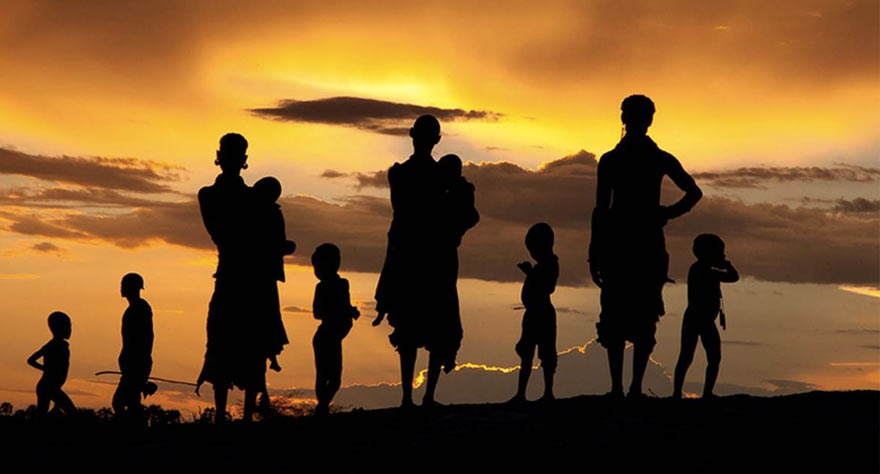
A surprisingly uplifting film considering the harrowing subject matter of children being killed in Ethiopia.

A surprisingly uplifting film considering the harrowing subject matter of children being killed in Ethiopia.
Few documentaries open as dramatically as Omo Child: The River and the Bush. Headlights pierce the dead of night somewhere in Southwest Ethiopia, a jeep pulls up at a settlement, and a man in Western-style clothing gets out. He is led into the darkness to another man, dressed in tribal gear, who is cradling a tiny baby. “He found her in the bush.” someone explains. “Is she alive?” someone else asks. The answer is obvious.
John Rowe’s gripping documentary introduces us to the Kara tribe of the Omo valley. They live off the land in a remote part of the country, their elders strikingly decorating their bodies with white markings. Like many indigenous tribes living in isolated parts of the world, the Kara are a deeply superstitious people, and believe that children can be born with a curse that will threaten their very existence. For generations, these cursed Mingi children have been killed by the women of the tribe, by strangulation, drowning, or leaving them in the bush for wild animals to take care of.
Our protagonist is Lale Labuko, a well-spoken and pleasant-featured young tribesman. His father stood up against the village elders to send him for some new fangled “education”, only recently introduced to the tribe by visiting missionaries. On his return, Lale discovered the truth about the taboo Mingi killings, which claimed his two older sisters as victims. He set out to save Mingi children from certain death by adopting them as his own, bringing them up far away from his ancestral home, and eventually challenging the Kara elders to bringing the barbaric tradition to an end.
Rowe and his intrepid crew filmed over a period of five years, and the documentary works best when dealing with the rhythms of tribal life. He has a real photographer’s eye for both the landscape and the people, and his images are particularly eloquent when focusing on the hard-worn faces of the elders and their women folk, many of whom have lost children to the Mingi curse.
The director is less confident dealing with narrative and the pacing of Omo Child drags because of it. This could be because our modern-day expectations of documentary filmmaking, and the material at Rowe’s disposal in such a challenging shooting location. So many documentaries today are a montage of footage from various sources, from CCTV to smartphones, giving them a sense of urgency and spontaneity that old skool documentaries rarely had. Perhaps by necessity, Rowe has to rely on straight up testimony to tell the tale. There’s plenty of gorgeous landscape shots interspersed with talking heads giving their account. The endless talking heads have the effect of slowing a riveting tale down, and perhaps a more experienced filmmaker may have found ways to show rather than tell. The result sometimes feels a bit National Geographicky.
Still, the retro style of the filmmaking doesn’t hamper the overall punch of the documentary. This is the story of one man who had the courage to challenge the accepted wisdom of his society, dealing with death threats and succeeding in bringing about a change. The film won the Ethos Jury Prize at this year’s Social Impact Media Awards.
Rowe sensibly allows the elders to voice some opinion. They are wistful about the modernization of their culture. One woman tells how traditionally the tribe would wear animal skins, but the kids just want to wear Western attire. Despite their resistance to the modern world, traces of modernity are found—some elders sport bucket hats like those favoured by Oasis and Ocean Colour Scene in their Britpop heyday; guns look even more brutal and deadly when handled by a half-naked tribesman.
The most shocking testimony is from an older woman who unapologetically admits to murdering twelve children without any remorse. Rowe encourages some empathy with the elder’s feelings—Omo Child is also a portrait of a community in transition, and treats their deep-rooted superstitions with respect.
Ritualized infanticide may be shocking to our sensibilities, but the film allows you to understand that to the elder’s sensibilities it would seem crazy not to kill these children when a curse is potentially hanging over the community. As Lale’s crusade gathers pace, one elder talks about letting the Mingi kids live with the air of incredulity some Westerners adopt when speaking about Political Correctness Gone Mad.
Despite the harrowing subject matter, Omo Child is an uplifting film. It enthusiastically demonstrates how one person can make a huge difference, and Lale Labuko’s fearless endeavours make it easy to overlook that Omo Child sometimes resembles an extended showreel for his organization. Beyond his exceptional work saving children’s lives in Ethiopia, his story also offers some hope to us all in our era of fear and intolerance.